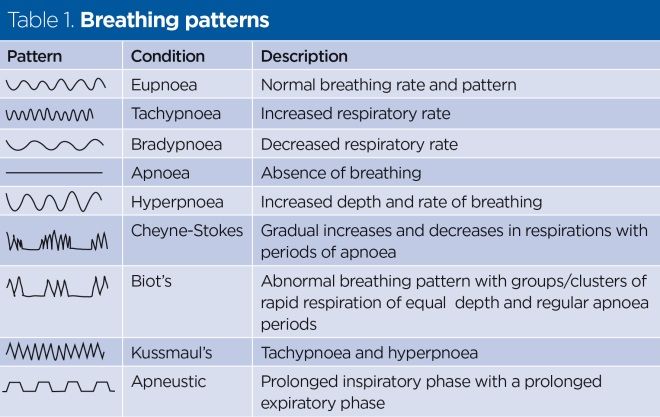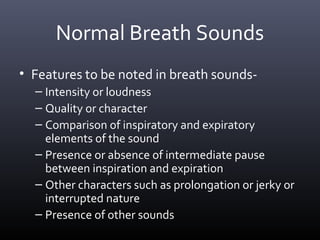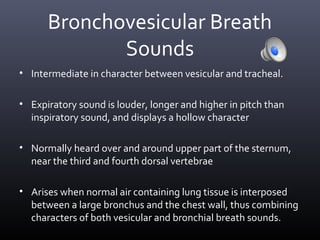Adventitious Lung Sounds Introduction. On this page we provide a definition and then examples of several types of adventitious breath sounds using audio recordings and text.

Respiratory Rate 4 Breathing Rhythm And Chest Movement Nursing Times
Expiration longer than inspiration with pause between inspiration expiration.

. Duration of expiration is usually equal to inspiration. Breath sounds are described as normal when the expected sound is heard in the expected area. The intensity and character of breath sounds help determine the location and pathology of thoracic disease.
The most common word for breathing is respiration which is often broken down by definition into two actions - to inhale and exhaleThere is also the technical term for normal breathing which is eupnoeaHowever the word breathing itself would seem to be descriptive enough for most usagesIf you are searching for an onomatopoeic word for the sound of. During expiration these noises are hardly audible. 20-30 breaths per minute.
There are two normal breath sounds. Normal breath sounds are classified as bronchial bronchovesicular and vesicular. 18-26 breaths per minute.
NORMAL AND ABNORMAL BREATH SOUNDS. Small clicking bubbling or rattling sounds in the lungs. List and describe 3 types of normal breath sounds.
The diaphragm ascends and the lungs return to their original state so the the CO2 is expelled. List and describe 3 types of normal breath sounds. Breath sounds are classified into normal tracheal sound normal lung sound or vesicular breath sounds and bronchial breath sound.
Bronchial and vesicular. Normal breath sounds vesicular sounds Inspiratory phase longer than expiratory phase without interposed gap. Normal breath sounds are heard over the chest wall or trachea.
Many authorities have described abnormal breath. List the five phases included in Korotkoffs sounds and describe what type of sound is heard during each phase. Breath sounds heard over the tracheobronchial tree are called bronchial breathing and breath sounds heard over the lung tissue are called vesicular breathing.
Normal Breath Sounds Vesicular Sounds edit edit source The intensity and quality of breath sounds depends on the site of Auscultation. 23-35 breaths per minute. Blowing Hollow tube or Aspirate in character.
Vesicular Breath Sounds. Sounds produced in the large airways have some of their energy content attenuated and filtered during conduction through pulmonary tissue so that only a narrow range of frequencies normal patients. A normal breath sound is similar to the sound of air.
Normal breath sounds are characterized by a low noise heard during inspiration. Abnormal or adventitious sounds are classified as crackles wheezes stertor and stridor. Normally it is difficult to hear breath sounds.
Auscultation of lungs help determine the airway and alveolar integrity ventilation and presence of abnormality. Forced the breath from her lungs fought for more oxygen gasping gasping at his touch grew short halted hard harsh and uneven harsh rush of his breath he fought for his breath heavily heaving like a bellows hissed hot and moist in fits and starts in little gasps irregular labored more rapidly. 4 The inspiratory component of the sound is mostly generated within the lobar and segmental airways while the expiratory component is produced from more proximal areas.
10 rows Normal Breath Sounds Kozier 613 Type Description Location Characteristics Vesicular. Deep low pitched rumbling sound more audible during expiration. Intensity of expiration is more than that of inspiration.
Rhonchi a low-pitched breath sound crackles a high-pitched breath sound. Tracheal bronchial bronchovesicular vesicular. Anterior upper sternum in 1st and 2nd intercostals spaces.
Crackles or rales wheezes or rhonchi. Links to the free training courses are noted as well. Describe the character of normal breath sounds.
Vesicular breath sound is the normal breath sound heard over most of the lung fields during auscultation. 1 The sound is not musical and there are no discrete peaks. Sounds that resemble snoring.
-Bronchial - high pitch loud inspiration expiration harsh hollow tubular trachea. They are heard when a person breathes in inhales. The term adventitious breath sounds refers to extra or additional sounds that are heard over normal breath sounds.
The expiratory phase is shorter because the breath sounds produced in the latter 23 of expiration are. Due to transmitted air turbulence. Anterior upper sternum in 1st and 2nd intercostals spaces.
This website offers free and paid lessons auscultation guides and quizzes for adventitious breath sounds. It is soft and low-pitched low frequency and the expiratory phase is shorter than the inspiratory phase. Normal breath sounds will seem faint or distant when auscultating.
This is a normal feature of breath sounds. Characteristics of bronchial breath sounds. Quiet and barely audible.
Tubular- This is a high-pitched bronchial breath sound which is commonly found in Consolidation. Wheeze-like sound heard when a. The normal breath sound heard over major bronchi characterized by moderate pitch and an equal duration of inspiration and expiration Chronic obstructive pulmonary disease COPD a functional category of abnormal respiratory conditions characterized by.
State the normal ranges of respiration for all age groups. Basically breath sounds contains background noises on which adventitious sounds are sometimes superimposed. Dry or wet intermittent sounds that vary in pitch.
Heard over areas of consolidation where sound is not filtered by alveoli. Posterior bn scapulae more on right side. The only place where.
30-40 breaths per minute. However abnormal breath sounds may include. The 4 most common are.
They occur when air is blocked or air flow becomes rough through the large. Amphoric breath sounds less common. Sources differ as to the classification and nomenclature of these sounds but most examiners commonly use the following terms to describe adventitious breath sounds.
Posterior bn scapulae more on right side. -Bronchial - high pitch loud inspiration expiration harsh hollow tubular trachea.

Twitter 上的pt Flashcards Pulmonaryassessment101 Auscultation Of The Lungs Includes Breath Sounds Its Character And Intensity Vocal Resonance And Adventitious Sounds Https T Co 3ttxoquydn Twitter


0 Comments